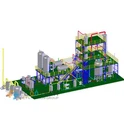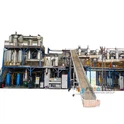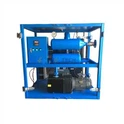Selecting the correct oil purification system is critical for maintaining industrial machinery health and maximizing oil life. Different oil types have unique contamination profiles and sensitivities, demanding specific filtration approaches:
1. Hydraulic & Circulating Oils:
Primary Contaminants: Fine particles (wear metals, dust), water (dissolved & free), air.
Recommended Purifier: High-Efficiency Particulate Filters + Vacuum Dehydration. Systems combining fine particulate filtration (often down to ISO 14/12/10 or better using Beta 1000≥200 filters) with vacuum chambers effectively remove free and dissolved water and entrained air. Coalescers may handle free water initially. Electrostatic filters excel for sub-micron particles in critical systems.
2. Turbine Oils:
Primary Contaminants: Water (especially dissolved), fine particles, varnish precursors (oxidation by-products), air.
Recommended Purifier: Vacuum Dehydration (VDU) + Fine Particulate Filtration. VDUs are essential for deep dehydration. Fine particulate filters (Beta 1000≥1000 for 3-6 microns) control wear. Polyester (or equivalent synthetic) filter media is mandatory** to avoid cellulose fiber shedding. Add-on varnish removal columns (ion exchange, depth media) are highly beneficial for longevity.
3. Gear Oils:
Primary Contaminants: Large wear particles, sludge, water (free & emulsified).
Recommended Purifier: Robust Particulate Filtration + Free Water Removal. Systems with high dirt-holding capacity, handling higher viscosities, using depth media or high-strength mesh/synthetic media are key. Coalescing separators effectively remove free water. Focus is often on larger particle removal (e.g., 25-40 microns initially, finer for high-speed gears) but finer filtration improves life. EP additives can limit dewatering efficiency.
4. Transformer Oils (Insulating Oils):
Primary Contaminants: Water (dissolved & free), particles, dissolved gases.
Recommended Purifier: Vacuum Dehydration (VDU) + Fine Particulate Filtration. Deep vacuum dehydration is paramount for dielectric strength. Fine particulate filtration (often offline, Beta 1000≥1000 at 1-5 microns) maintains cleanliness. Systems must be sealed against moisture ingress. Polyester/synthetic media is standard.
Key Selection Principles:
Contaminant Focus: Identify the primary threat (water, particles, varnish, air).
Viscosity: Ensure the purifier handles the oil's viscosity range, especially cold.
Additive Sensitivity: Avoid aggressive methods (e.g., excessive heat, certain adsorbents) that could strip additives (common in EP gear oils).
Media Compatibility: Use cellulose-free media for systems sensitive to fibers (turbines, some hydraulics). Match media to contaminant size and type.
Flow Rate & Environment: Choose portable, offline, or online systems based on need.
Using the wrong purifier risks inadequate cleaning, additive depletion, or even oil/system damage. Matching technology to the specific oil type ensures optimal fluid cleanliness (achieving target ISO codes), maximizes equipment reliability, and extends oil service life.











